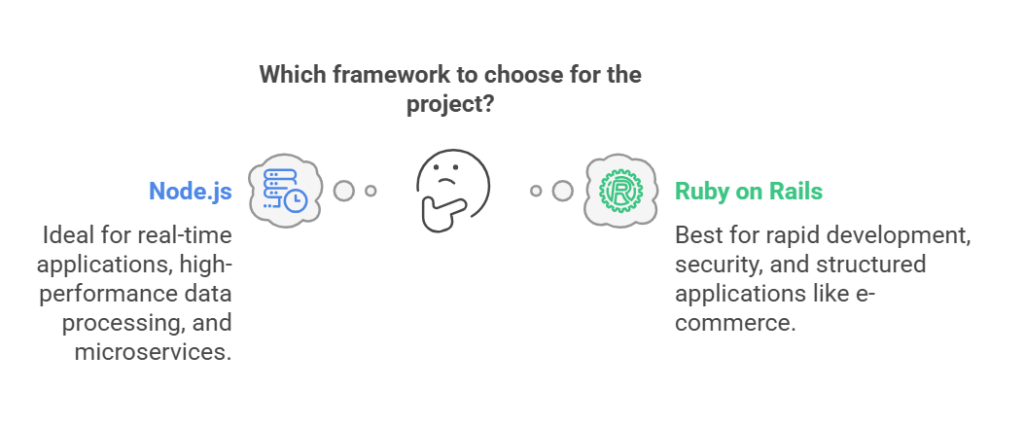
Choosing the right backend framework is a pivotal decision that shapes the efficiency, scalability, and long-term success of a web application. Two of the most powerful and widely used backend technologies are Node.js and Ruby on Rails, each offering unique strengths for different types of projects. Ruby on Rails, known for its rapid development capabilities and convention-over-configuration philosophy, has long been a go-to choice for startups and businesses needing quick deployment. On the other hand, Node.js, with its non-blocking, event-driven architecture and high-performance execution, is the preferred choice for real-time applications and microservices.
Companies like Netflix, PayPal, and LinkedIn have transitioned to Node.js for its speed and scalability, while platforms like Shopify and GitHub continue to thrive on Ruby on Rails. Understanding the differences between these two frameworks is crucial in determining the best fit for your project. In this article, we will provide an in-depth comparison of Node.js and Ruby on Rails, analyzing their performance, scalability, security, ease of use, and ideal use cases.
Feature Node.js Ruby on Rails1. Performance High-speed, non-blocking I/OSlower due to synchronous execution2. Scalability Highly scalable with microservicesScalable but requires additional resources3. Development SpeedSlower due to manual configurationsFaster with built-in conventions4. Security Requires manual security implementationsStrong built-in security features5. Flexibility Highly flexible, many frameworks availableOpinionated and structured framework6. Concurrency Handling Handles multiple requests simultaneouslyLess efficient at handling concurrent connections7. Real-Time Applications Ideal for chat apps, live streaming, and gamingNot optimized for real-time processing8. Learning Curve Easier for JavaScript developersEasier for structured, guided learning9. Ecosystem & Libraries Large npm ecosystem with many librariesRich Ruby Gems ecosystem10. Community Support Large, active JavaScript communityStrong, dedicated Ruby on Rails community11. Use in Enterprise SolutionsWidely used in tech companies like Netflix, PayPalUsed by Shopify, Airbnb, and GitHub12. Best Use Cases APIs, microservices, real-time appsMVPs, e-commerce, CMS platforms13. Code MaintainabilityRequires best practices for clean codeReadable and structured code14. Cost of Development Lower due to widely available JavaScript talentCan be higher due to limited Ruby expertise
Performance is a crucial factor when choosing a development framework, especially for applications handling large-scale traffic.
Node.js is known for its exceptional speed and efficiency. It operates on Google’s V8 JavaScript engine, which compiles JavaScript into machine code for faster execution. Its non-blocking, asynchronous nature allows it to handle multiple concurrent connections with ease. This makes Node.js an excellent choice for applications requiring real-time processing, such as chat applications, gaming platforms, and financial dashboards.
Ruby on Rails, on the other hand, follows a synchronous execution model, making it slightly slower in handling concurrent requests. The framework is optimized for developer productivity rather than raw performance. While RoR is efficient for traditional web applications, it may introduce bottlenecks in high-traffic scenarios. That said, optimizing database queries, caching mechanisms, and proper load balancing can significantly enhance its performance.
Winner: Node.js for high-performance applications.

Scalability is essential for applications expected to grow in terms of user base and complexity.
Node.js is highly scalable due to its event-driven architecture. It efficiently manages multiple simultaneous connections, making it an excellent choice for large-scale applications. Moreover, its compatibility with microservices architecture allows developers to break down applications into smaller, manageable components, further enhancing scalability.
Ruby on Rails can be scaled effectively, but it requires more resources than Node.js. Applications built with RoR need additional configurations, such as horizontal scaling using multiple server instances. Large-scale RoR applications like Shopify and Airbnb demonstrate that Rails can scale, but it requires careful planning and resource allocation.
Winner: Node.js for effortless scalability.
For startups and businesses looking to deploy applications quickly, development speed is a key consideration.
Ruby on Rails is known for its rapid development capabilities. It follows the “convention over configuration” philosophy, providing built-in conventions, modules, and tools that accelerate development. Features like scaffolding, Active Record, and a robust ORM make it easier for developers to build applications quickly.
Node.js, being more flexible, requires developers to manually configure various components, including selecting frameworks and libraries. While this flexibility is an advantage, it can slow down development compared to Rails. However, frameworks like Express.js and NestJS can help streamline the process.
Winner: Ruby on Rails for rapid development.
Security is a critical aspect of web applications, especially those handling sensitive user data.
Ruby on Rails has robust built-in security measures. It includes protections against SQL injection, cross-site scripting (XSS), and cross-site request forgery (CSRF). Additionally, RoR enforces secure coding practices through its well-defined conventions.
Node.js also offers strong security capabilities, but it requires more manual configurations. Developers need to integrate third-party security modules and ensure best security practices are followed to prevent vulnerabilities.
Winner: Ruby on Rails for built-in security.
Flexibility determines how much control developers have over the framework and project architecture.
Node.js is highly flexible, allowing developers to choose from multiple frameworks like Express.js, Koa, and NestJS. This makes it a good choice for applications requiring customized solutions tailored to specific business needs.
Ruby on Rails is more opinionated, following a structured approach to development. While this ensures consistency, it limits flexibility for developers who need extensive customization.
Winner: Node.js for flexibility.

Node.js is the preferred framework for real-time applications that require instant data processing and seamless communication. It is ideal for chat applications, online gaming platforms, and collaborative tools. High-performance applications that process large amounts of data benefit from Node.js due to its non-blocking, event-driven architecture. Additionally, Node.js is well-suited for API development, enabling seamless integrations with various services.
Microservices-based architectures thrive with Node.js, as its lightweight and modular structure allows for easy scalability and independent service management. Streaming services, such as Netflix, also leverage Node.js for efficient handling of data streams and uninterrupted media delivery. If your project requires speed, real-time capabilities, and scalable architecture, Node.js is the optimal choice.
Ruby on Rails is ideal for projects that require rapid development, structured coding, and security. It’s a great choice for startups and MVPs due to its convention-over-configuration approach, which speeds up development. E-commerce platforms like Shopify benefit from RoR’s scalability and database efficiency. Content management systems and business applications also thrive on its structured framework. If your project prioritizes security and maintainability, RoR provides built-in protection against common vulnerabilities.
For businesses that need robust backend solutions with integrated database management, Ruby on Rails offers a seamless approach. Applications that handle user authentication, financial transactions, or confidential data benefit from its strong security measures. Furthermore, if you seek an established, well-supported framework with extensive community resources, RoR remains a solid choice.
The choice between Node.js and Ruby on Rails depends on your project requirements. If you need a high-performance, scalable application with real-time capabilities, Node.js is the better choice. On the other hand, if you prioritize rapid development, security, and structured coding, Ruby on Rails is the ideal framework.
Choosing between Node.js and Ruby on Rails depends on the nature of your project, performance requirements, scalability needs, and development priorities. If your project demands high concurrency, scalability, and real-time data processing, Node.js is the superior option.
Its asynchronous, non-blocking architecture makes it ideal for chat applications, gaming platforms, and streaming services. On the other hand, Ruby on Rails is an excellent choice for startups, MVPs, and database-driven applications where rapid development and security are paramount. Its convention-over-configuration approach ensures faster development cycles, making it an attractive option for e-commerce platforms and content management systems.
Both frameworks have their strengths and weaknesses, and the right choice ultimately depends on your specific project goals. By analyzing their advantages, limitations, and use cases, you can make an informed decision that aligns with your business and technical requirements.
Let Neuronimbus chart your course to a higher growth trajectory. Drop us a line, we'll get the conversation started.
Your Next Big Idea or Transforming Your Brand Digitally
Let’s talk about how we can make it happen.